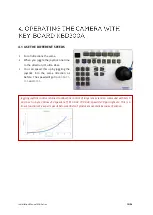
Installation Manual MK-Series
4/24
Installation should be done only by qualified installers and conform to all local codes.
It is the users’ responsibility to ensure that the mounting methods are safe and adequate for
the location.
Use only stainless steel hardware to fasten the mount to an outdoor surface.
All servicing should be performed by qualified service personnel. Procedures in this manual
do not require entry into the housing of the camera positioning system. The unit contains
potential high voltage. It also contains sensitive devices that can be damaged by static
discharge. To reduce the risk of electric shock and damage to the unit by static discharge do
not perform any servicing other that described in these instructions. If the unit is defective,
please contact the Customer Service Department for technical assistance.
Liability: It is the sole responsibility of the installer to provide proper installation in compliance
with all local codes and regulations.
The Evve Long Range products are part of the next generation of Long Range camera systems,
ranging from high-definition (HD) to standard-definition (SD) camera positioning systems. The
systems are IP (Internet Protocol) based with a full function built-in operating system. Operator
functions features are controlled from the On Screen Display (OSD).
A drive system positioned within the MK-2000HD Series camera permits full 360° continuous pan
and 90° tilt movements. The camera systems comply with MIL-STD-18F standards for temperature,
shock, and vibration specifications. For environmental protection the camera systems use an IP67
camera head enclosure and IP66 positioner enclosure.
For more information on specifications and datasheets, please refer to specific product pages at Evve
Long Range website: www.evvelongrange.com/downloads.
At 50km the pixels per meter in
height will be 8. Assuming man is
2m approx. then 8 pixels is
Detection.
At 5km the pixels per meter in
height will be 40. Assuming man
is 2m approx. then 80 pixels is
Identification, i.e. it’s a man or
woman.
SAFETY INSTRUCTIONS
CLASS 3 (EYE & SPECULAR REFLECTION HAZARD):
Never aim the laser at a person’s eye or stare at the laser from within the beam.
Keep the beam path above or below eye level for one seated or standing.
Laser safety eyewear is needed if MPE (Maximum Permissible Exposure) is exceeded.
Don’t view beam directly with optical instruments unless a protective filter is used.
Only experienced and authorized individuals are permitted to operate the laser.
Secure the laser from operation by unauthorized personnel. A key switch should be used if
unauthorized personnel may gain access to the laser.
Always strive to enclose as much of the beam path as practical and to operate the laser in a
controlled access area.
During alignment, avoid placing one’s eye near the axis of the beam path, where specular
reflections are most likely to occur. Alignment eyewear should be considered.
Unnecessary specular (i.e., mirror-like) reflecting objects should be removed from the beam
path.
Mount the laser on a firm support to ensure the beam travels along its intended path.
Post laser hazard warning signs at entrances to laser use areas.







































